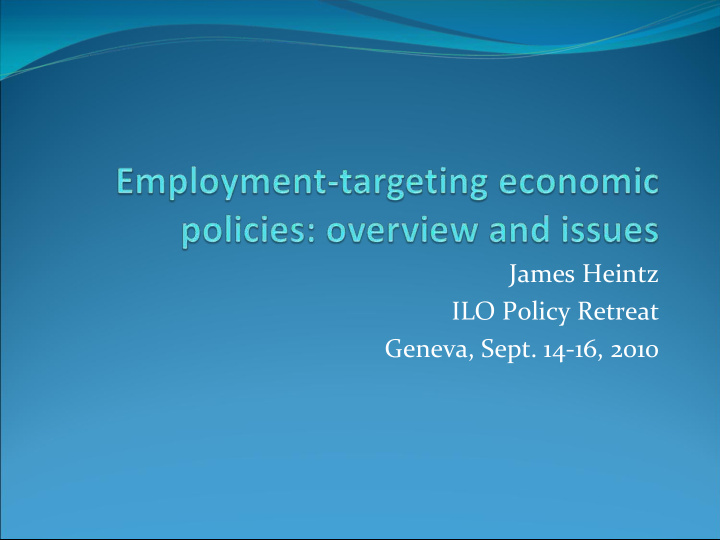



James Heintz ILO Policy Retreat Geneva, Sept. 14 ‐ 16, 2010
Why talk of ‘employment targeting’? Alternative to other frameworks for economic policy: inflation ‐ targeting. Stresses real outcomes, not nominal/ monetary variables Growth for poverty reduction (‘pro ‐ poor’) Primary channel through which benefits of growth are distributed. But employment targeting is not the only option ….
Other approaches to ‘pro ‐ poor growth’ Maximize the growth rate redistribute income to address poverty, human development. Acknowlege: maximizing growth does not maximize employment. Past (neoliberal) policies to promote growth do not automatically reduce poverty/ inequalities. Compensate ‘losers’ in the game of global growth. Approach implicit in some PRSPs. Justification for cash ‐ transfers. De ‐ linking from employment. ‘De ‐ commodify’ labour – normative principle
Employment matters Non ‐ monetary costs of joblessness (not just about income) Social cohesion: external costs/benefits (e.g. unemployment and violence/crime) The ‘leaky bucket’ of redistribution. Employment – fewer leaks. Politically viable levels of redistribution through non ‐ employment channels may be limited. Labour as a source of income and a factor of production (generates income, matching incentives) Solid justification for emphasizing employment – but employment ‐ targeting does not adress everything.
Structure of Employment What categories/patterns of employment predominate? Three dimensions (more are possible) Sector/industry (e.g. agric, industry, services) Status in employment (ICSE – plus) Formality status (social/legal/regulatory protections) Dimensions overlap, but are not identical Gender is critical: disaggregate by sex (also: youth) Supplement with information on hours, earnings, poverty rates, etc.
Employment ‐ targeting policies: key aspects Labour Demand – reduce unemployment, underemployment, job creation, etc. (‘quantity’). Includes the self ‐ employed. Labour Mobility/Supply – can individuals take advantage of new opportunities when available? Includes structural barriers: skills deficiencies, unpaid care work, transportation, infrastructure, discrimination. Labour’s ‘terms of trade’ – under what conditions is labour exchanged? Returns to labour relative to costs of living Bargaining power & social dialogue Social protection Need to move beyond the neoclassical model of labor markets. Structural/institutional factors are central.
Employment ‐ targeting policies: approaches Describe the structure of employment and constraints to improving employment opportunities (labour demand, mobility, and terms of trade). Multiple diagnostic tools (quantitative: statistical, modeling; qualitative: focus groups, in ‐ depth surveys) Objective: to develop policies that relax these constraints (macro, institutional, micro) How should we think about the structure of employment Short ‐ run: improve employment taking the structure of employment as given Long ‐ run: development policies to transform the structure of employment to improve outcomes
Concrete employment ‐ targeting: monitoring and evaluation To actually set ‘employment targets’ – need appropriate indicators. DATA, DATA, DATA Timely and representative? Sufficient variables? Existing data often under ‐ analyzed No shortage of indicators – draw on what exists, but adapt to specific contexts.
Concrete employment ‐ targeting: accountability Inflation ‐ targeting central bank policy Announce target (transparency) Ostensibly held accountable for reaching target Parallel for employment ‐ targeting? Not clear that a strong parallel exists Inter ‐ ministerial, inter ‐ governmental coordination essential Who is ultimately accountable for employment policy? Is their a clear coordinating mechanism?
Recommend
More recommend